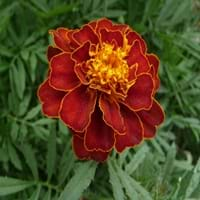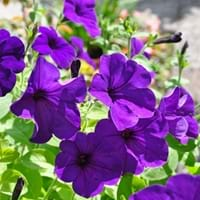Type
Flowering Plants, Shrubs
Flowering Plants, Shrubs
Origin
Mexico, Central America
Hybrid origin
Types
African or American Marigolds, French Marigolds, Mule Marigolds
19
Habitat
Roadsides, wastelands
Terrestrial
USDA Hardiness Zone
9-11
9-10
AHS Heat Zone
12 - 1
12 - 3
Sunset Zone
A1, A2, A3, H1, H2, 1a, 1b, 2a, 2b, 3a, 3b, 4, 5, 6, 7, 8, 9, 10, 11, 12, 13, 14, 15, 16, 17, 18, 19, 20, 21, 22, 23, 24
A1, A2, A3, H1, H2, 1a, 1b, 2a, 2b, 3a, 3b, 4, 5, 6, 7, 8, 9, 10, 11, 12, 13, 14, 15, 16, 17, 18, 19, 20, 21, 22, 23, 24
Habit
Clump-Forming
Prostrate/Trailing
Flower Color
Yellow, Red, Orange, Gold, Dark Red, Orange Red
White, Blue, Purple, Pink, Light Pink, Hot Pink, Magenta, Lavender
Flower Color Modifier
Bicolor
Bicolor
Fruit Color
Brown
Not Available
Leaf Color in Spring
Dark Green
Green
Leaf Color in Summer
Dark Green
Green
Leaf Color in Fall
Dark Green, Burgundy
Green
Leaf Color in Winter
Light Green
Light Green
Plant Season
Summer, Fall
Spring, Summer, Fall
Sunlight
Full Sun
Full Sun
Growth Rate
Fast
Very Fast
Type of Soil
Loam, Sand
Loam, Sand
The pH of Soil
Acidic, Neutral, Alkaline
Acidic, Neutral
Soil Drainage
Well drained
Well drained
Bloom Time
Early Summer, Summer, Late Summer, Early Fall, Fall, Late Fall
Indeterminate
Tolerances
Drought
Drought
Where to Plant?
Container, Ground, Pot
Container, Ground, Pot
How to Plant?
Seedlings
Seedlings, Transplanting
Plant Maintenance
Medium
Medium
Watering Requirements
Allow soil to be completely dry in between waterings, Form a Soil ring to water efficiently, Keep the ground moist but not water-logged, Water in morning to avoid prompting diseases, Water when soil is dry
Keep the ground moist but not water-logged, Requires regular watering, Requires watering in the growing season
In Summer
Lots of watering
Lots of watering
In Spring
Moderate
Moderate
In Winter
Average Water
Average Water
Soil pH
Neutral, Slightly Alkaline
Neutral
Soil Type
Well drained
Loamy, Sandy
Soil Drainage Capacity
Well drained
Well drained
Sun Exposure
Full Sun, Part sun
Full Sun, Partial shade
Pruning
Prune ocassionally, Remove dead or diseased plant parts, Requires little pruning
Cut or pinch the stems, Do not prune during shooting season, Remove dead or diseased plant parts, Remove deadheads
Fertilizers
All-Purpose Liquid Fertilizer
All-Purpose Liquid Fertilizer
Pests and Diseases
Alternaria Leaf Spot, Bacterial leaf spot, Damping-off, Gray mold, Powdery mildew, Root rot
Red blotch
Plant Tolerance
Drought
Drought
Flower Petal Number
Single, Double, Semi-Double
Single
Fragrant Bark/Stem
Yes
No
Foliage Texture
Fine
Medium
Foliage Sheen
Matte
Matte
Attracts
Butterflies
Hummingbirds, Butterflies
Allergy
no allergic reactions
Not Available
Aesthetic Uses
Showy Purposes
Beautification, Bouquets, Showy Purposes
Beauty Benefits
Not Available
Not Available
Environmental Uses
Air purification
Air purification
Medicinal Uses
Burns, constipation, Inflammation, Upset stomach, Wounds
Not Available
Part of Plant Used
Flowers, Seeds
Flowers
Other Uses
Can be made into a herbal tea, Decoration Purposes, Used As Food
Showy Purposes
Used As Indoor Plant
Yes
Yes
Used As Outdoor Plant
Yes
Yes
Garden Design
Bedding Plant, Edging, Foundation, Houseplant, Mixed Border
Hanging Basket
Botanical Name
TAGETES patula
PETUNIA 'PAS3187'
Common Name
French Marigold
Purple Wave Petunia, Spreading Petunia, Wave Purple Petunia
In Hindi
फ्रेंच गेंदा
Purple wave petunia
In German
Französisch Marigold
Lila Welle Petunie
In French
Marigold français
Pétunia pourpre Vague
In Spanish
Marigold francés
Petunia púrpura Wave
In Greek
Γαλλικά Marigold
Purple Wave πετούνια
In Portuguese
Marigold Francês
Onda roxa do petúnia
In Polish
francuski Marigold
Purpurowy fali petunii
In Latin
French Zinnia
Purpura unda Petunia
Phylum
Tracheophyta
Magnoliophyta
Class
Magnoliopsida
Magnoliopsida
Order
Asterales
Solanales
Family
Asteraceae
Solanaceae
Clade
Not Available
Angiosperms, Asterids, Eudicots
Tribe
Not Available
Not Available
Subfamily
Not Available
Petunioideae
Importance of French Marigold and Purple Wave Petunia
Want to have the most appropriate plant for your garden? You might want to know the importance of French Marigold and Purple Wave Petunia. Basically, these two plants vary in many aspects. Compare French Marigold and Purple Wave Petunia as they differ in many characteristics such as their life, care, benefits, facts, etc. Every gardener must at least have the slightest clue about the plants he wants to plant in his garden. Compare their benefits, which differ in many ways like facts and uses. The medicinal use of French Marigold is Burns, constipation, Inflammation, Upset stomach and Wounds whereas of Purple Wave Petunia is Not Available. French Marigold has beauty benefits as follows: Not Available while Purple Wave Petunia has beauty benefits as follows: Not Available.
Compare Facts of French Marigold vs Purple Wave Petunia
How to choose the best garden plant for your garden depending upon its facts? Here garden plant comparison will help you to solve this query. Compare the facts of French Marigold vs Purple Wave Petunia and know which one to choose. As garden plants have benefits and other uses, allergy is also a major drawback of plants for some people. Allergic reactions of French Marigold are no allergic reactions whereas of Purple Wave Petunia have Not Available respectively. Having a fruit bearing plant in your garden can be a plus point of your garden. French Marigold has no showy fruits and Purple Wave Petunia has no showy fruits. Also French Marigold is not flowering and Purple Wave Petunia is not flowering . You can compare French Marigold and Purple Wave Petunia facts and facts of other plants too.





